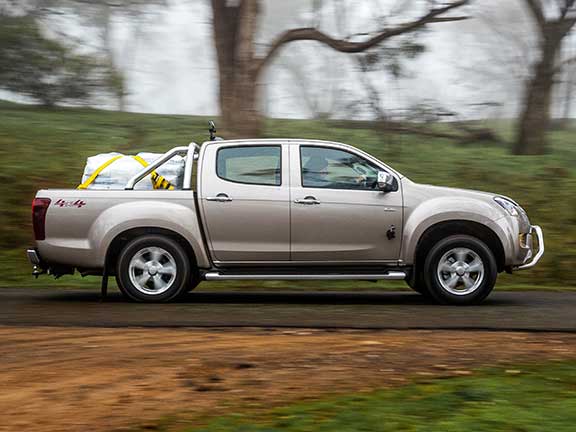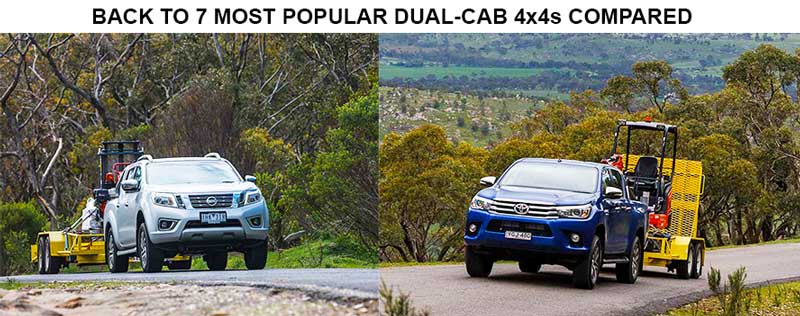The Isuzu D-Max is one of the oldest designs here, so is it up to competing with the new boys?
 |
|
It’s hard not to use words like bombproof when it comes to the D-Max
|
As before, the Isuzu D-Max’s tub has four decently sized tie-down hooks and, with the 800kg loaded and secured, the rear ride height dropped around 60mm – as good as the least affected of all the utes here. Not that this is a definitive measure, given the vagaries of the age and history of the assembled utes – it’s only another piece of information. Our total payload of 970kg (including driver, etc.) is 40kg to 80kg shy of the max figures of the various D-Max dual-cab 4×4 pick-ups, so very close to max payload.
With the 800kg pallet in the tub and heading up, the D-Max felt a little nose-up at the front, but it didn’t bottom out on any of the bumps. And while the steering felt a little light, the chassis felt generally composed, stable and confident.
Not so good is the D-Max’s 3.0-litre engine that felt the weight of the tub more than any of the others in the test. While the maximum power of 130kW is competitive with the less powerful engines here, its 380Nm of torque max is between 53Nm and 90Nm short of what the others offer. This lower torque output translates to less power off idle and at low rpm, something you don’t want when hauling a big load up a steep hill.
The D-Max still got the job done, but it had to work at it more than the others. It is, after all, a much older engine design than any of the others here, and even predates this generation D-Max. The engine refinement is also nothing special in this company.
The five-speed auto also does the engine few favours. Not only does it have fewer ratios than all but the Triton’s auto, but there’s nothing flash also about the way it shifts up or down the hill. Like the engine, it’s an older design.
But there is a flipside to all this in as much as the D-Max’s engine is a robust and reliable Isuzu in-house design that’s done more than a few laps. Likewise, the gearbox is well proven and comes from an Aisin gearbox family previously widely used by Toyota in Prado and LandCruiser models.
With the deadline for Euro 5 emission compliance looming, Isuzu will have to do something engine-wise for the D-Max for MY17, even if it’s just an addition of a diesel particulate filter. Perhaps the changes will run deeper than that, and there will be more power and torque as well…
TOW TEST
The unassuming Isuzu and its lack of pretence make it a sentimental favourite with many. The hard-working Isuzu shares the underpinnings of the Holden Colorado, yet it has been the preferred choice as a workhorse for those in the know. A virtually bulletproof 3.0-litre engine and five-speed auto transmission combo has gone a long way to building this reputation over a relatively short period of time.
The Isuzu took our load reasonably well. The D-Max’s bum sagged a little under the weight, but its stoicism gives you the impression it’ll have a crack at anything.
In this current climate, however, the D-Max has been seriously challenged in terms of performance and refinement by the recent onslaught of product in this segment. In true Isuzu fashion, the D-Max had a serious crack at the title. The venerable 130kW/380Nm powerplant aimed to please, but was left wanting in this company. And, like the Navara, it also lacks electronic trailer sway control.
The generational lag between the Isuzu and the rest of the flock is very apparent at max weight. On uphill drags the D-Max roared, clambered and snorted, yet didn’t deliver the kind of performance set by its rivals. The tacho hovered at 3000rpm in second slot and it stayed there as the D-Max hauled its way to the top of the hill.
The rear end also had a tough time with a bit of bump steer out back. Steering feel remained reasonably composed, and the Isuzu was easily controlled on the up and down. Again, the five-speed self-shifter may be a tough unit, but it’s not the most intuitive bit of gear. On the upside, the engine did help hold back our load on the downhill runs once there was some manual intervention with the cog ‘box.
You do, however, get the impression that the Isuzu would take this sort of beating day in and day out without a hiccup.
ISUZU D-MAX PRICE
Isuzu D-Max SX: $42,800
Isuzu D-Max LS-M: $44,900
Isuzu D-Max LS-U: $46,100
Iuszu D-Max LS-Terrain (auto): $53,000
*4×4 dual-cab pick-up manuals only, unless otherwise noted.
ISUZU D-MAX SPECS
Engine
3.0-litre 4-cyl turbo diesel
Max Power/torque
130kW/380Nm
Gearbox
Five-speed automatic
4×4 system
Dual-range part-time
Tare weight
1910kg to 1940kg
GVM
2950kg
Payload
1010kg to 1940kg
Towing capacity
3500kg
Towball download (max)
350kg
GCM
5950kg
Fuel tank capacity
76 litres
ADR fuel claim
8.1 litres/100km
*4×4 dual-cab pick-up automatics only.
Photography: Ellen Dewar and Nathan Jacobs



